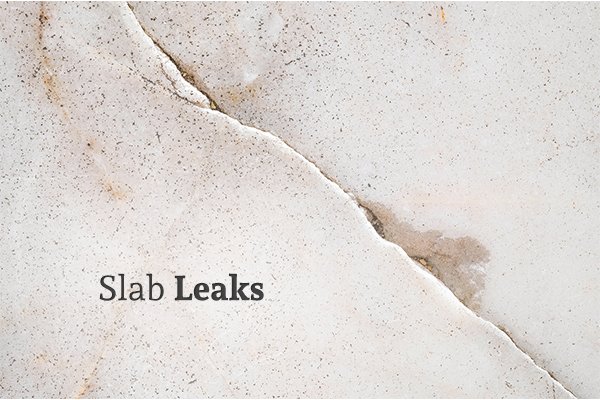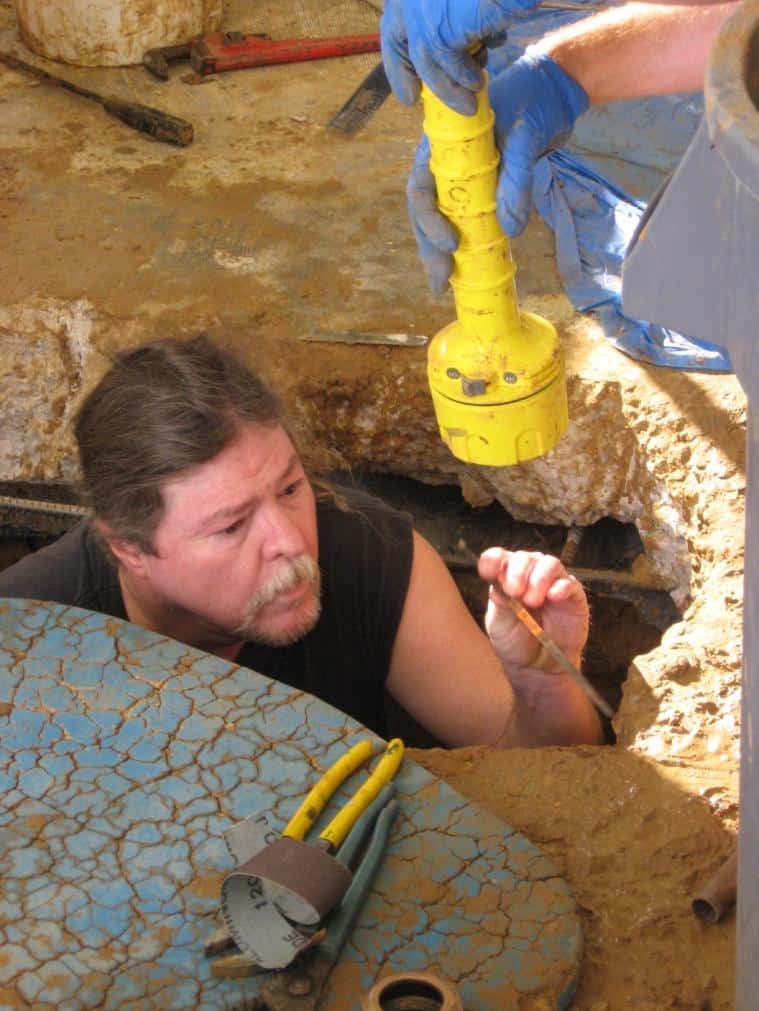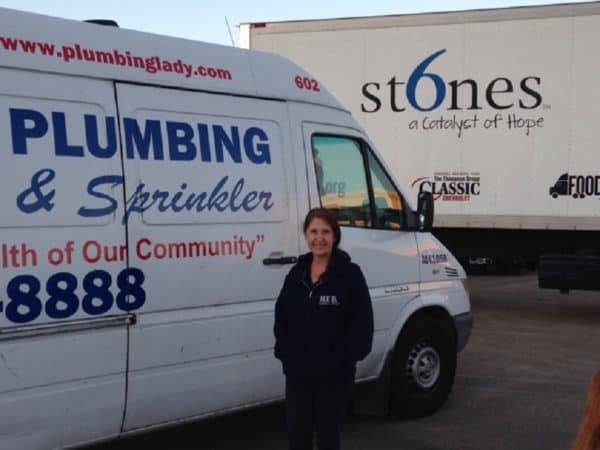
Table of contents
In Texas, many homes are built on slabs. A slab foundation has plumbing roughed in underneath it, offering several benefits. However, if a slab leak occurs, it can be hard to detect and go unnoticed for long periods. This can cause expensive damage to your property and foundation.
This blog post will discuss slab leaks and the signs of one occurring.
If you need help detecting or repairing a slab leak, contact the experts at HEB Plumbing & Sprinkler.
What is a Slab leak?
A slab leak is when a building built with concrete slab construction experiences a water line leak beneath the slab. Due to the nature of slab leaks, they can be hard to detect, cause extensive damage, and even create health hazards.
Common Causes of a Slab Leak
Several issues cause slab leaks, with the following being a few examples. Please note that this list is not comprehensive.
Pipes Corroding
Over time, pipes can experience corrosion, allowing leaks to occur.
Abrasion
Damage to pipes can occur when they rub up against the slab or other objects.
Bad Installation or Poor Quality Materials
Incorrectly installed pipes may fail early. For example, the use of poor quality materials, incorrectly laid lines, or lack of insulation may cause pipe failure.
Shifting Soil
The clay soil found in North Texas areas such as Bedford is prone to expanding and shrinking. When clay soil gets wet, it expands, and when it dries, it shrinks. Shifting soil puts pressure on pipes, potentially resulting in cracks.
High Water Pressure
Pipes experiencing constant high water pressure will wear down more quickly. Joints and connections are particularly susceptible to this.
Seismic Activity
Seismic activity can damage pipes in areas prone to earthquakes.
Why Early Detection of a Slab Leak Matters

As with any leak, the sooner a slab leak is detected and repaired, the less damage it does. Slab leaks occur in sensitive areas of buildings and can cause significant damage that can worsen over time. It could even cause a building to collapse completely. Along with the damage slab leaks cause, they can also increase your water bill and lead to health issues.
Top 10 Signs of a Slab Leak
The following are the top ten common signs of slab leaks. Please note that other signs exist beyond these.
Unexplained Increase in Water Bills
A number of issues can cause water bill increases, but slab leaks are a common one. A change in your regular water bill may indicate a slab leak. Please note that increases in water bills can come from other sources, such as leaks that aren’t slab leaks, water usage variations, and seasonal water use changes.
Monitoring and Comparing Your Water Bills
To determine if your water bill has increased due to a water leak, monitor your water bills and compare them to past ones. Compare with previous months and the year, if possible. Take note of significant increases in water usage that don’t have an explanation, such as a swimming pool being filled or a house guest.
If you note a small increase in the water bill over the course of several months, it could indicate a slow leak worsening over time. If a large increase in water usage occurs, it could be due to pipe rupture.
Other Potential Water Usage Increases
The following are several other potential reasons for water usage increases besides slab leaks.
- Other leaks — Check for other leaks such as those from running toilets, faucets that drip, or leaks from other pipes in your home.
- Water use changes — Try to think of any changes in your home that could cause a change in water usage, such as another person in your home, additional water-using appliances, or a change in your lawn watering schedule.
- Seasonal deviations — See if water usage increases follow a seasonal pattern. Water usage may increase in the summer due to lawn watering and more frequent showers.
A slab leak is more likely if none of these are the reason for the water usage increase.
Damp or Wet Spots on Floors
Although slab leaks occur under slabs, a bad enough leak can cause floors to become wet and damage them. Look for unexplained damp or dark spots on carpets and warping on hardwood, linoleum, or laminate flooring. If there is no obvious reason for the source of the water, it may be due to a slab leak. Sections of carpet that are perpetually soggy without an obvious reason are another sign of slab leaks.
Warm Spots on the Floor
Slab leaks often occur in hot water lines. These leaks can eventually seep through the slab to the floor above them. These spots may be warm or hot to the touch and are most noticeable on hardwood, linoleum, laminate, and other types of solid wood floors. If you walk across warm spots on the floor, a professional should look into it as a potential slab leak.
Finding Warm Spots
Touch
The most basic way to find warm spots on floors is by walking barefoot across them, especially in areas where hot water lines are likely to be. Some of these places can include paths in between your water heater and kitchens or bathrooms.
Infrared Thermometers
If you know how to use an infrared thermometer, you can scan your floors to find differences in temperature.
Sound of Running Water
If you believe you may have a slab leak, turn off the water in your home (faucets, dishwasher, washing machine, etc). When you’ve done that, go to the first floor of your home and listen carefully for the sound of running water. The running water may make a whooshing or hissing noise. Please note that a gas leak also can make a hissing noise, so treat it like a gas leak and take the appropriate steps.
Investigating the Noise’s Source
Once you confirm there is no gas leak in the case of a hissing sound, work on identifying the noise’s source.
- Check all faucets — Ensure no faucets are dripping or leaking. A small drip from a faucet could be mistaken for echo noises from pipes.
- Inspect toilets — A slab leak may sound similar to a running toilet. Make sure the toilets quit filling when full.
- Inspect the water meter — Shut off all water sources and check your water meter. If the meter continues to move, it’s a sign of a leak.
Cracks in Walls or Flooring
When water leaks out from a pipe under the slab and into the soil, it can shift the ground and damage your home’s structural integrity. Slab leaks can cause cracks in floors, walls, and even foundations. Wall cracks can be on external or internal walls.
External Signs
- Walk around your property regularly and look for signs of cracks in the foundation.
- Check for cracks on the exterior walls.
Signs on the Building’s Interior
- Cracks on inside walls, particularly ones that look step-like or vertical, might indicate trouble with your foundation.
Low Water Pressure
Slab leaks can reduce water pressure as less water is available, which can cause a weak flow and fluctuating water pressure. When this happens, the effects can be felt throughout your home in places like faucets and showers. Because of this, everyday tasks such as washing your hands can become a hassle.
Issues such as maintenance disruptions or appliance usage spikes can cause minor fluctuations. But significant drops in pressure are indicated by a consistent weak stream and a widespread problem that goes beyond a specific fixture.
Please note that low water pressure can be caused by a number of issues besides a slab leak, including but not limited to:
- Problems with pipes not under slabs.
- Issues with municipal water supplies.
- Problems with pressure regulators.
- Old or corroded pipes.
- Multiple fixtures or appliances being used at the same time.
Low Water Pressure Signs
- Water flow is weak — Faucets or showers with previously good water flow now flow weakly.
- Flow is inconsistent — Drastic changes in pressure occur without other water sources being used.
Differentiating Normal Fluctuations from Sudden Pressure Drops
Normal Fluctuations
- Peak water usage times — Minor pressure reductions in the morning or evening could be due to high water demand in your area.
- Temporary pressure disruptions — Local maintenance work may occasionally cause water pressure to dip, or in-home water usage may dip because water-using appliances, like washing machines, are in use.
Significant Water Pressure Drops
- Look out for constant low water pressure that doesn’t improve with time.
- Check for several fixtures with low water pressure.
Troubleshooting Other Low Water Pressure Causes
The following are several common causes of low water pressure you may want to look into before suspecting a slab leak.
Clogged Shower Heads or Faucets
- Problem — Low flow only occurs at one shower head or faucet.
- Solution — The fixture may need to be removed and cleaned.
Municipal Water Issues
- Problem — Your neighbors are also experiencing low water pressure.
- Solution — You’ll need to contact your local municipal water company to see if there is an issue with the water supply.
Problems with Pressure Regulators
- Problem — Low water pressure occurs unexpectedly throughout your home.
- Solution — Contact a plumber and have them inspect your pressure regulator and replace it if necessary.
Pipes are Old or Corroded
- Problem — Water is discolored or you experience a gradual drop in water pressure over time.
- Solution — A plumbing professional will need to inspect and potentially repair or replace your pipes.
Mildew or Mold Under Carpets
When slab leaks occur, moisture may get trapped under your floors. This can create an environment ripe for mold and mildew growth, such as under carpets. If you see or smell mold or mildew, have the problem corrected as soon as possible. Take care around mildew and mold, as they can be detrimental to your health and even fatal in some cases.
Mold and mildew can spread throughout your home, and affected areas such as floors and drywall may need to be replaced.
Foundation Shifts
Slab leaks can cause soil to expand or erode. This soil supports the foundation of the building, and when slab leaks affect it, it can cause uneven settling. Prolonged moisture exposure can weaken concrete.
Some signs of foundation shifting include but are not limited to the following:
- Doors or windows with gaps or that no longer open and close properly.
- Gaps appearing between counters or cabinets and walls. While a small gap is commonplace, a growing gap or gaps in multiple locations are a sign of trouble.
- Floors with an irregular slope, unevenness, sags, or dips.
- Wood or vinyl floors buckling or warping, or tile floor cracking.
- Warped or separated siding.
- A cracked or leaning chimney.
- Nails coming out of drywall. While a few nails coming out of drywall may be due to poor installation, a lot coming out at the same time may be due to a shifting foundation.
- Basement walls bowing.
Unusual Odors
A musty odor may indicate unseen moisture, which could be trapped beneath your floors. The musty smell tends to be damp and earthy, similar to rotting wood or wet socks.
Some potential sources of musty odors include but are not limited to:
- Humidity and dampness — Slab leaks can cause excessive moisture to increase the humidity levels in homes, potentially leading to mold growth and causing musty odors.
- Mildew and mold — Slab leaks cause water to accumulate beneath the foundation, creating an optimal spot for mold and mildew to grow. This often creates a musty smell.
- Water leaks from other sources — Musty odors can also stem from other leaks besides slab leaks, such as in places like ceilings, walls, and crawl spaces where a constant damp area occurs.
Visible Water Puddles Around Your Home
Puddles around the home with no obvious source, such as sprinkler runoff or rainwater, could indicate a slab leak. Having moisture constantly around the foundation can weaken it, highlighting the importance of taking action quickly to have the leak repaired.
This water puddling may occur inside or outside of your home.
Interior Indications of Potential Slab Leaks
- Wet floors — A potential sign of a slab leak is random wet spots on your hardwood floors that can’t be explained by drips, spills, or condensation.
- Soggy carpets — Sections of carpet are constantly wet for no apparent reason.
Exterior Indication of a Potential Slab Leak
- The building has water around it — If water has pooled around your home without an obvious source, such as runoff from a sprinkler or rainwater, it may be due to a slab leak.
What to Do if You Suspect a Slab Leak
If you believe a slab leak is occurring, you’ll want to take action ASAP.
Step 1. Try to confirm a leak — Keep tabs on your water bill. Look for visual indications of leaks and other aforementioned signs of leaks. If you suspect a leak or are unsure, take action by following steps two and three.
Step 2. Shut off the water if possible — If you can, you may want to shut off your water at the main to prevent further damage until you can have a professional inspection.
Step 3. Contact a professional plumber and your insurance provider — Contact a reputable plumber to repair the leak. It is important also to contact your insurance provider to determine if the repairs are covered.
How HEB Plumbing Detects and Fixes Slab Leaks

The plumbers at HEB Plumbing have the knowledge and equipment to find and repair your Bedford, Texas, area slab leaks. The following are ways we locate and repair them.
How HEB Plumbing Finds Slab Leaks
HEB Plumbing has several methods for locating slab leaks, even if they are in hard-to-reach areas. With technology, we strive to locate slab leaks without having to conduct extensive digging.
We can use the following techniques to accurately locate your slab leaks.
Acoustic Listening Devices
Acoustic listening devices help our plumbers locate a leak’s precise location by amplifying the water sound in a pipe. With this equipment, a plumber can hear where a leak is occurring.
Hydrostatic Pressure Testing
Hydrostatic pressure testing involves isolating sections of the plumbing system and then pressurizing them to look for signs of drops in pressure that would indicate leaks.
Thermal Imaging Cameras
When water leaks from a pipe, the temperature of nearby materials changes. Our plumbers can detect these temperature changes using thermal imaging.
Fiber Optic Camera
Fiber optic cameras can be inserted into water pipes to help our plumbers locate issues such as leaks.
Slab Penetration
We may try slab penetration if other leak detection methods aren’t working. To do this method, our plumbers make access points in floors to reach the pipes. Then, they use tools to visually inspect the pipes for signs of damage or leaks.
How HEB Plumbing Repairs Slab Leaks
HEB Plumbing can repair slab leaks in several ways. We can advise you on the best way for us to repair your slab leak.
The following are common techniques for slab leak repair.
Tunneling Beneath the Slab
Tunneling beneath a slab prevents plumbers from having to break through your slab to access pipes, averting a mess being made in your home. However, excavation and grading work will need to be conducted.
Trenchless Pipe Repair
Trenchless pipe repair is less disruptive than conventional slab leak repair and doesn’t require extensive digging. Trenchless pipe repair consists of several methods. Please note that cured-in-place pipelining, aka CIPP, can lead to sickness and even death.
Rerouting Pipes
Pipe rerouting is when a new pipe is installed to bypass an existing pipe. Pipes can be rerouted to several areas, such as walls, attics, or other places, allowing them to avoid shifting soil.
Repiping
Repiping is when existing pipes are replaced.
Breaking Through the Slab
If other options aren’t possible, plumbers may need to break through the slab to access the pipes. To do this, the slab is broken through with a jackhammer and the ground is dug up.
Why Choose HEB Plumbing for Slab Leak Detection and Repair in Bedford and Surrounding Areas?

When you need slab leak detection and repair in Bedford and the surrounding areas, go with the professionals at HEB Plumbing. We’ve proudly served Bedford, Texas, and the surrounding areas like Euless, Colleyville, and Hurst since 1980. We are licensed and proudly maintain an A+ rating with the Better Business Bureau. Our work has earned us many five-star ratings.
The team at HEB Plumbing has the equipment and knowledge to detect and repair slab leaks. Don’t wait for the problem to worsen; contact us for slab leak detection and repairs.
